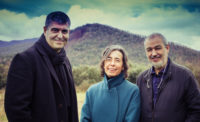German architect Frei Otto, renowned for his lightweight, tensile structures, today was named the winner of the 2015 Pritzker Architecture Prize. The abrupt announcement came a day after Otto died at the age of 89 in Germany.
“Throughout his life, Frei Otto has produced imaginative, fresh, unprecedented spaces, and constructions,” wrote the Jury in their citation. “He has also created knowledge. Herein resides his deep influence: not in forms to be copied, but through the paths that have been opened by his research and discoveries.”
Otto learned of his award earlier this year when the prize’s executive director, Martha Thorne, travelled to his home in Warmbronn, Germany, a city near Stuttgart.
Otto’s works include a diverse array of structures and installations, which broadened the architectural possibilities of grid shells, pneumatic structures, canopies, and lattices. He is best known for his cable net structure for the German Pavilion at Expo 67 in Montreal, and an expansive roofing structure for the 1972 Munich Olympics, which stretched over the Game’s stadium, pool, and public areas.
Like his unconventional architecture, Otto’s architectural training took an extraordinary path: he was initially prevented from studying architecture because he was drafted into the German army during World War II. As a prisoner of war in France, Otto worked as a camp architect and learned to work frugally with minimal materials. He later returned to study architecture after the war at the Technical University of Berlin, and in 1952, he founded his own office in that city.
Otto, who was fascinated by natural forms—from soap bubbles to spider webs—was known for his collaborative and wide-ranging approach to research and design and frequently worked with philosophers, scientists, and historians. In 2000, Otto partnered with Shigeru Ban (the recipient of the 2014 Pritzker Architecture Prize) to design the Japanese pavilion at the 2000 Hannover Expo.
He served as a professor at the University of Stuttgart from 1964 until 1991 and published numerous works on architecture and engineering. Over the years, Otto received many accolades including the Aga Khan Award for Architecture (1980), the Grand Prize of the German Association of Architects and Engineers (1996) and the Royal Institute of British Architects (RIBA) Gold Medal (2005).
“I will use whatever time is left to me to keep doing what I have been doing, which is to help humanity,” Otto said when he was alerted of the news earlier this year. “You have here a happy man.”





























